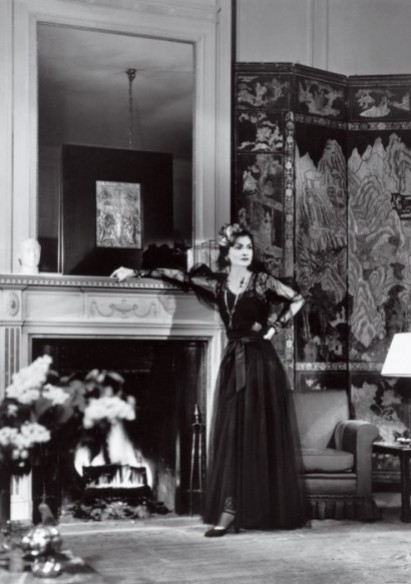Some legends are perhaps better left untouched. Or unsniffed, as the case may be. Because, sometimes, the legend is closer to a myth. That was, unfortunately, my experience with Cuir de Russie, the legendary Chanel fragrance that is now part of its Les Exclusif line of perfumes. 
Cuir de Russie (or “Russian leather”) is one of those scents that perfume junkies would talk about in hushed tones of reverence and awe. The vintage, original Cuir de Russie always seemed to me to be some sort of mythical animal, the perfume equivalent of a unicorn. Its name would shine in haloed light above distant snowy mountain tops and I almost expected a choir of angels to burst into rhapsodic song at its very mention.

Coco Chanel & her imperial Grand Duke.
Cuir de Russie was inspired by Coco Chanel’s passionate affair with a Russian Grand Duke, His Imperial Highness Dimitri Pavlovich Romanov, a cousin to the last Tsar. According to Wikipedia, Chanel’s biographer considered Cuir de Russie to be the “bottled … essence of her romance with the Grand Duke.” It was created by Ernst Beaux, Chanel’s then perfumer, sometime in the 1920s when Paris was flooded with Russian emigrés, both royal and common, who had escaped the Bolshevik revolution. (Chanel’s website gives the date of the perfume’s release as 1927, but I’ve always read it was in 1924.)
The Chanel website majestically declares Cuir de Russie to be an “imperial fragrance” and a “leather oriental” before adding:

The Grand Duke in his uniform.
The Russian influence at the heart of Mademoiselle’s creations was born from her encounter with the Grand Duke Dimitri, cousin of Tsar Nicholas II. Cuir de Russie, launched in 1927, is the fragrance of wild cavalcades, wafts of blond tobacco and the smell of boots tanned by birch bark, which the Russian soldiers would wear.
This sensual fragrance reveals the dark and musky scents of balms, Frankincense and Juniper Wood. Fruity zests of Mandarin Orange and Bergamot add a touch of insolence before giving way to the grace and fragility of eternal flowers: Rose, Jasmine and Ylang-Ylang. A ‘thoroughbred’ fragrance with a strong character, it holds within it the ambiguous secrets of femininity…
Somewhere in the decades following its release, Cuir de Russie seems to have faded into the mists of legend. I can’t determine when it was discontinued or why, but it just became that mythical perfume unicorn. Then, in 1983, Chanel brought it back. Trumpets blared, perfumistas fainted, and all wept with joy as the heavens burst forth in song. Chanel’s in-house perfumer, Jacques Polge, re-worked it slightly, toning down its legendary leather notes and increasing the iris for a more powdery note, but it was back and that is all anyone cared about.
The return of Cuir de Russie was hailed as a massive triumph by even that most ascerbic and disdainful of critics, Luca Turin. In his book, Perfumes The A-Z Guide, his five-star review states:
There have been many other fragrances called Cuir de Russie, every one either too sweet or too smoky. This one is the real deal, an undamaged monument of classical perfumery, and the purest emanation of luxury ever captured in a bottle.
[All] sumptuous leather, light and balsamic, forgoing any sugary compromise, Cuir de Russie regains its place at the top of this [Leather] category, right next to the rather more jovial Tabac Blond. […]Cuir de Russie is a striking hologram of luxury bygone: its scent like running the hand over the pearl grey banquette of an Isotta Frashini while forests of birch silently pass by”.
(First quote taken from Perfume Niche, and the second from the Perfume Shrine.)
Luca Turin is not alone in genuflecting before the shrine to the most holy of leather perfume holies. If I were to provide mere snippets of the adoring praise for Cuir de Russie — even a minute fraction of them! — I suspect I would writing this review until sometime in the year 2018. There are reviews on Fragrantica which expound for paragraph after paragraph about:

Coco at her Ritz apartment.
Cossacks on horseback on the steppes of Russia; semi-erotic imaginings involving the seduction of a languid Coco by her sweaty, horse-riding royal lover amidst the plush decadence of her Paris apartment at the Ritz; and about olfactory masterpieces involving the very scent of Coco Chanel’s sex and sweat-infused bedsheets. There was one from a fellow perfume blogger whom I deeply respect and admire which made me want to go take a cold shower, or find some ermine and jewels in which to roll around naked.
All of which makes me feel completely insane for not loving it. But I don’t. On me, it is none of the things described above, and I am crushingly disappointed by a scent that is, at best, average and occasionally pleasant. At worst, it is a barnyard filled with horse manure under a layer of soap. In short, I am one of the very few freaks in this world who finds the legend of Cuir de Russie to be a mere myth.
The notes listed in Chanel’s description up above are the same ones listed on Fragrantica. Elsewhere, however, I’ve read a significantly larger and fuller list. I assume that the notes are essentially the same in both vintage and modern versions, with only the amount of certain ingredients differing. If so, then the full notes for Cuir de Russie are:
aldehydes, orange blossom, bergamot, mandarin, clary sage, iris, jasmine, rose, ylang-ylang, cedarwood, balsams, vetiver, styrax, incense, cade, leather, amber and vanilla.
Cuir de Russie opens on me with an explosion of aldehydes. (You can read more about aldehydes in the Glossary.) On me, it is a waxy, lemony, floral impression that is first and foremost soapy, and without any of the fizzy aspects that I often read about with aldehydes. As many of you know, I loathe soapy scents. And I suspect my dislike of the soap accord in aldehydes is why I dislike Chanel No. 5, and one of the reasons why I’m far from enraptured by Cuir de Russie. (Christ, I’m admitting that I don’t like the two most legendary Chanel perfumes ever. I may need to hide in witness protection. Mea Culpa.)
Initially, the burst of soap is like a thick lens, clouding and obscuring the citrus notes, but about five minutes later, I suddenly smell soapy leather. Specifically, I get a strong impression of a riding saddle and stirrups lathered with sweat. There is a strong smell of sour, sweaty horse. I shudder faintly, and wonder momentarily if the heinous soap smell was better. I should have enjoyed the sweaty saddle fragrance while it lasted because, suddenly, waves of horse manure (cow dung?) and soap are emanating off my arm. I…. I… am stunned, and have no idea what to do. I quickly turn to Google and, there, on both Makeupalley and Basenotes, amidst the legions of gushing, cooing, almost delerious praise, I find a few rare nuggets of comfort. I am not completely alone or totally crazy.
Snippets of those rare (very rare!) criticisms of Cuir de Russie are as follows:
- It was an overwhelming animalistic scent, like the smell of entering a barn and having the smells of animals and their droppings mixing with straw and leather.
- This leather is more of the fecal farmhouse animal stench variety and is somewhat difficult to tolerate. […] Luckily, the barnyard aspects of the scent recede in the base notes. […] The opening of Cuir de Russie edt was difficult from the get-go and did not portend to good things to come. I tend to be quite sensitive to fecal aspects in scents (like my problem with Jicky, for example), and as such the heart notes with their fecal smelling leather and powdery iris were really not to my taste at all. If things stopped there this would be a definite thumbs down for me. What saves Cuir de Russie edt somewhat is it has a very nice dry-down that easily is the best part of the scent.
And, that’s basically it — because even those who can smell the fecal aspect of Cuir de Russie love it. As it is, that last quote came from someone who ended up giving Cuir de Russie a neutral rating due to the “nice” dry-down that she mentioned. Other than a few negative criticisms involving dirty ashtrays (not a frequent impression), almost no-one who smelled the barnyard scent or “cow patties” hated it. Seriously, they didn’t!
- Cuir de Russie, however, was love at first sniff. It opens with a dirty animalic note that’s borderline fecal, but the soft, creamy, spicy florals seep in and smooth out this animal’s shaggy fur until Cuir de Russie becomes this heart-achingly beautiful blend with an undercurrent of barely-bridled danger; a lady in leather and lace, a sleek panther at repose in a meadow.
- I really love the opening, when a true leather unfolds, bitter, dry, almost harsh, even a briefly passing “faecal” note, all in all, it smells like the inside of a fairly new, precious leather bag, that’s containing some scented cosmetics in its depths. But all too soon, this stage is fading away, moving over into a softer, creamier leather, which is still fine and very likeable.
- All I can say is — poop. This stuff smells like poop. But in a really kind of good, fascinating way. Seriously, that’s the genius of Chanel. It’s like the poop of some delicate animal who’s only grazed upon a field of violets. I’m not sure I want to wear it, but I simply could not stop smelling the crook of my arm all day after my spritz! Pretty awesome.
There was even a review on MakeupAlley upbraiding Chanel’s perfumer, Jacques Polge, for toning down the original scent and demanding that they bring back more of the leather and barnyard!
Clearly, I am alone in disliking “the poop of some delicate animal who’s only grazed upon a field of violets.” (It is not a “delicate” animal, by the way, and I could only wish it had eaten bloody violets!) I certainly don’t want even more of this opening that so many adore and wish were as intense as it used to be.
As I try to figure out how I landed in a pile of horse manure, I come across a really interesting explanation on Perfume Niche. Apparently, it’s the birch wood that helps creates that leather tannery and barnyard scent:
Rectified birch tar is the smoky resinous note which makes Cuir de Russie, and most leather scents, smell like leather. It is, in fact, the dry-cooked resin from the bark of the birch tree and has been used for centuries to cure leather, and to “dress” it, as in polishes for military leather boots. […] [Then] after the florals subside, Cuir de Russie conjures the uber-male, becoming a sexy masculine scent. That raw edge – the funky animalics, civet and castoreum – mix with the smoky leather, balsam and woods , giving Cuir de Russie an erotic, brutish quality.
I’m afraid I don’t see any “erotic, brutish” quality in Cuir de Russie. I would undoubtedly like it a lot more if it were half as interesting as all these descriptions would seem to convey. I keep wondering what the legendary vintage version must have been like if the current eau de toilette toned down the leather. Perhaps I should try to hunt down the concentrated extrait de parfum version which is supposed to be more intense, more “brutal,” heavier and thicker? I consider the downsides of a heavier version of soapy horse feces, and quickly change my mind.
About 30 minutes in, Cuir de Russie is already incredibly close to the skin. Apparently, it’s supposed to be. However, with the way my skin consumes perfume, it makes it difficult to assess its full range and development properly, so I start from scratch. I follow the advice of a Basenoter and put on triple the previous amount (on some clean skin). I have the same experience as the first time round, but this time, the perfume’s sillage is much better. (Apparently, I need to empty just over half the vial on me if I want to smell the dry-down properly.)
Unfortunately, I don’t get much of the lovely middle or bottom notes that others do. On me, it goes from: citric soap; to horse manure, sweaty saddles and soap; to a middle stage that is essentially a basic floral scent of strong jasmine, with bergamot, rose, powdery iris, and leather turned into soft suede. (The soap is still there too, though it’s a shadow of its former strength.) The jasmine part is lovely, and the rest of it is pleasant, but I shrug. Soon, the dry down begins: the suede impression is joined by a light touch of cedar, an even heavier dose of dusty powder from the iris, some definite musky notes, and a soft smoke and incense touch that is, I admit, lovely. There is also a note that strongly evokes hairspray. And, every  now and then, flitting back and forth, I smell something faintly horsey — though it is more leather saddles now than feces.
now and then, flitting back and forth, I smell something faintly horsey — though it is more leather saddles now than feces.
I feel like Camilla Parker-Bowles, Prince Charles’ horse-mad second wife, and recall the oft-repeated stories of her younger days. Rumour has it that, after a long day at the hunt, she would make a mad dash straight off her sweaty horse and into the house where she would tumble into a dress for a cocktail party, with nary a shower in-between.
I realise that my views are “sacrilegious,” to borrow the word of one fearful commentator on Basenotes who barely dared whisper the words “fecal” before rushing off to join in all the praise. If I could smell what Mick Jagger smells when he wears this (and he does); if I could see “The Ballet Russes, polished samovars and dangerous Cossacks with leather riding boots;” if I could conjure up Imperial Grand Dukes leaping off their black stallions to lasciviously and forcefully seduce me; if I could feel like a “virago” femme fatale or ultra-posh bombshell with hidden bondage tendencies– then I would probably genuflect at the alter of Cuir de Russie, too.
Until the time when all that magically occurs, I shall continue to think that Cuir de Russie is a perfectly pleasant, completely average floral musk with some suede notes under a strong head of horse manure. Literally.

